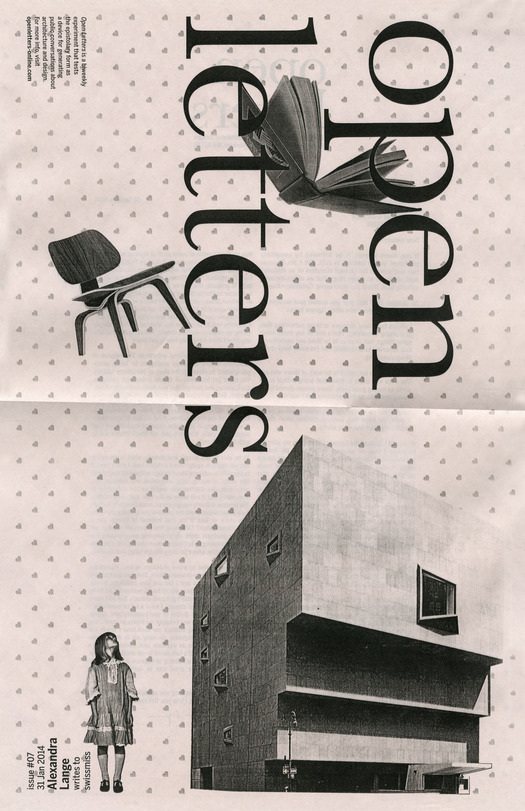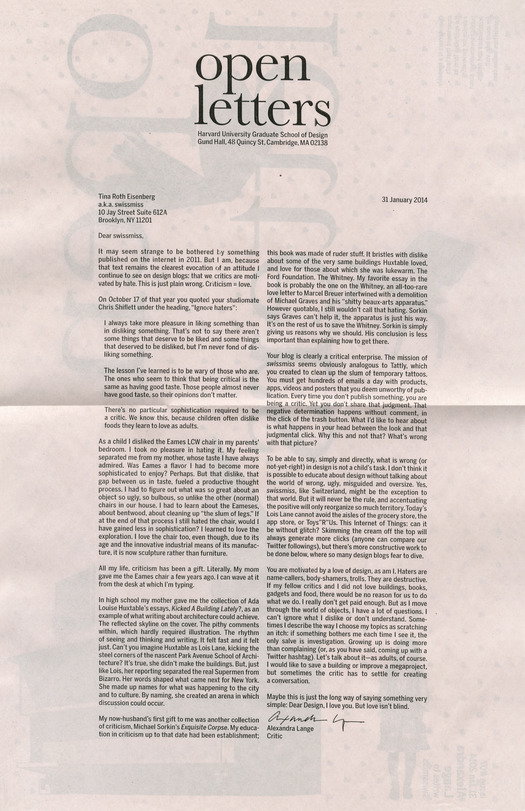
February 1, 2014
Criticism = Love

Open Letters is a print experiment that tests the epistolary form as a device for generating conversations about architecture and design. The publication was launched in September 2013 by students at Harvard’s Graduate School of Design. In preparation for the February 14 GSD symposium, What criticism?, I wrote the following letter to Tina Roth Eisenberg, a.k.a. swissmiss. It was published January 31.
Dear swissmiss:
It may seem strange to be bothered by something published on the internet in 2011. But I am, because that text remains the clearest evocation of an attitude I continue to see on design blogs: that we critics are motivated by hate. This is just plain wrong. Criticism = love.
On October 17 of that year you quoted your studiomate Chris Shiflett under the heading, “Ignore haters”:
I always take more pleasure in liking something than in disliking something. That’s not to say there aren’t some things that deserve to be liked and some things that deserved to be disliked, but I’m never fond of disliking something.
The lesson I’ve learned is to be wary of those who are. The ones who seem to think that being critical is the same as having good taste. Those people almost never have good taste, so their opinions don’t matter.
There’s no particular sophistication required to be a critic. We know this, because children often dislike foods they learn to love as adults.
As a child I disliked the Eames LCW chair in my parents’ bedroom. I took no pleasure in hating it. My feeling separated me from my mother, whose taste I have always admired. Was Eames a flavor I had to become more sophisticated to enjoy? Perhaps. But that dislike, that gap between us in taste, fueled a productive thought process. I had to figure out what was so great about an object so ugly, so bulbous, so unlike the other (normal) chairs in our house. I had to learn about the Eameses, about bentwood, about cleaning up “the slum of legs.” If at the end of that process I still hated the chair, would I have gained less in sophistication? I learned to love the exploration. I love the chair too, even though, due to its age and the innovative industrial means of its manufacture, it is now sculpture rather than furniture.
All my life, criticism has been a gift. Literally. My mom gave me the Eames chair a few years ago. I can wave at it from the desk at which I’m typing.
In high school my mother gave me the collection of Ada Louise Huxtable’s essays, Kicked A Building Lately?, as an example of what writing about architecture could achieve. The reflected skyline on the cover. The pithy comments within, which hardly required illustration. The rhythm of seeing and thinking and writing. It felt fast and it felt just. Can’t you imagine Huxtable as Lois Lane, kicking the steel corners of the nascent Park Avenue School of Architecture? It’s true, she didn’t make the buildings. But, just like Lois, her reporting separated the real Supermen from Bizarro. Her words shaped what came next for New York. She made up names for what was happening to the city and to culture. By naming, she created an arena in which discussion could occur.

My now-husband’s first gift to me was another collection of criticism, Michael Sorkin’s Exquisite Corpse. My education in criticism up to that date had been establishment; this book was made of ruder stuff. It bristles with dislike about some of the very same buildings Ada Louise Huxtable loved, and love for those about which she was lukewarm. The Ford Foundation. The Whitney. My favorite essay in the book is probably the one on the Whitney, an all-too-rare love letter to Marcel Breuer intertwined with a demolition of Michael Graves and his “shitty beaux-arts apparatus.” However quotable, I still wouldn’t call that hating. Sorkin says Graves can’t help it, the apparatus is just his way. It’s on the rest of us to save the Whitney. Sorkin is simply giving us reasons why we should. His conclusion is less important than explaining how to get there.
Your blog is clearly a critical enterprise. The mission of swissmiss seems obviously analogous to Tattly, which you created to clean up the slum of temporary tattoos. You must get hundreds of emails a day with products, apps, videos and posters that you deem unworthy of publication. Every time you don’t publish something, you are being a critic. Yet you don’t share that judgment. That negative determination happens without comment, in the click of the trash button. What I’d like to hear about is what happens in your head between the look and that judgmental click. Why this and not that? What’s wrong with that picture?
To be able to say, simply and directly, what is wrong (or not-yet-right) in design is not a child’s task. I don’t think it is possible to educate about design without talking about the world of wrong, ugly, misguided and oversize. Yes, swissmiss, like Switzerland, might be the exception to that world. But it will never be the rule, and accentuating the positive will only reorganize so much territory. Today’s Lois Lane cannot avoid the aisles of the grocery store, the app store, or Toys R Us. This Internet of Things: can it be without glitch? Skimming the cream off the top will always generate more clicks (anyone can compare our Twitter followings), but there’s more constructive work to be done below, where so many design blogs fear to dive.
You are motivated by a love of design, as am I. Haters are name-callers, body-shamers, trolls. They are destructive. If my fellow critics and I did not love buildings, books, gadgets and food, there would be no reason for us to do what we do. I really don’t get paid enough. But as I move through the world of objects, I have a lot of questions. I can’t ignore what I dislike or don’t understand. Sometimes I describe the way I choose my topics as scratching an itch: if something bothers me each time I see it, the only salve is investigation. Growing up is doing more than complaining (or, as you have said, coming up with a Twitter hashtag). Let’s talk about it—as adults, of course. I would like to save a building or improve a megaproject, but sometimes the critic has to settle for creating a conversation.
Maybe this is just the long way of saying something very simple: Dear Design, I love you. But love isn’t blind.
Alexandra Lange, Critic
Observed
View all
Observed
By Alexandra Lange
Related Posts

Business
Courtney L. McCluney, PhD|Essays
Rest as reparations: reimagining how we invest in Black women entrepreneurs

Design Impact
Seher Anand|Essays
Food branding without borders: chai, culture, and the politics of packaging

Graphic Design
Sarah Gephart|Essays
A new alphabet for a shared lived experience

Arts + Culture
Nila Rezaei|Essays
“Dear mother, I made us a seat”: a Mother’s Day tribute to the women of Iran
Recent Posts
Courtney L. McCluney, PhD|Essays
Rest as reparations: reimagining how we invest in Black women entrepreneurs Food branding without borders: chai, culture, and the politics of packaging Why scaling back on equity is more than risky — it’s economically irresponsible Beauty queenpin: ‘Deli Boys’ makeup head Nesrin Ismail on cosmetics as masks and mirrorsRelated Posts

Business
Courtney L. McCluney, PhD|Essays
Rest as reparations: reimagining how we invest in Black women entrepreneurs

Design Impact
Seher Anand|Essays
Food branding without borders: chai, culture, and the politics of packaging

Graphic Design
Sarah Gephart|Essays
A new alphabet for a shared lived experience

Arts + Culture
Nila Rezaei|Essays

 Alexandra Lange is an architecture critic and author, and the 2025 Pulitzer Prize winner for Criticism, awarded for her work as a contributing writer for Bloomberg CityLab. She is currently the architecture critic for Curbed and has written extensively for Design Observer, Architect, New York Magazine, and The New York Times. Lange holds a PhD in 20th-century architecture history from New York University. Her writing often explores the intersection of architecture, urban planning, and design, with a focus on how the built environment shapes everyday life. She is also a recipient of the Steven Heller Prize for Cultural Commentary from AIGA, an honor she shares with Design Observer’s Editor-in-Chief,
Alexandra Lange is an architecture critic and author, and the 2025 Pulitzer Prize winner for Criticism, awarded for her work as a contributing writer for Bloomberg CityLab. She is currently the architecture critic for Curbed and has written extensively for Design Observer, Architect, New York Magazine, and The New York Times. Lange holds a PhD in 20th-century architecture history from New York University. Her writing often explores the intersection of architecture, urban planning, and design, with a focus on how the built environment shapes everyday life. She is also a recipient of the Steven Heller Prize for Cultural Commentary from AIGA, an honor she shares with Design Observer’s Editor-in-Chief,